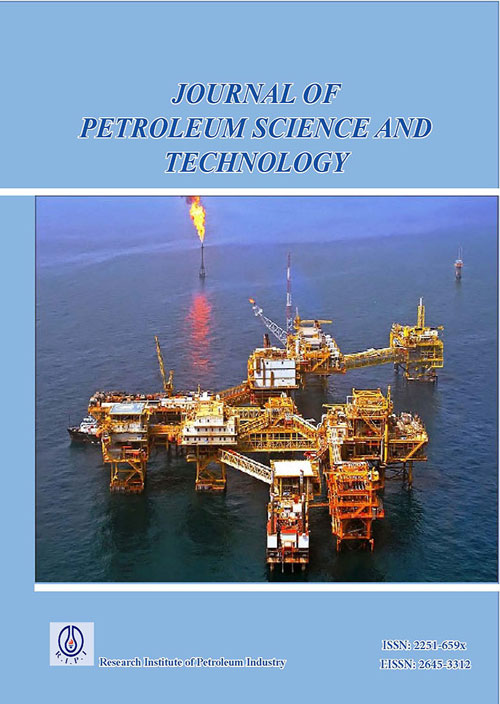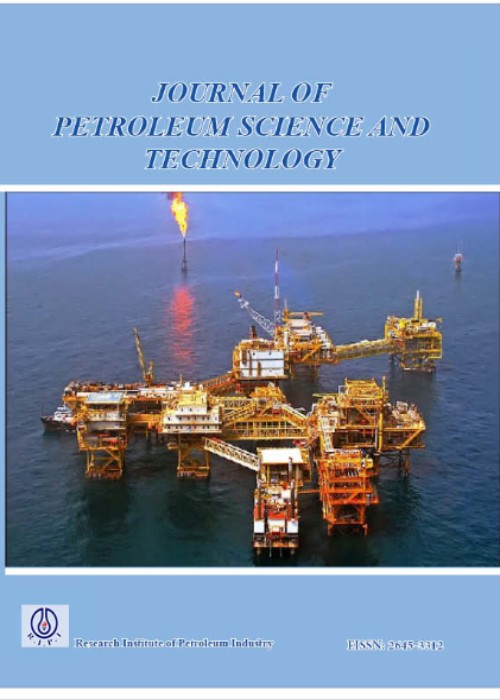فهرست مطالب

Journal of Petroleum Science and Technology
Volume:11 Issue: 1, Winter 2021
- تاریخ انتشار: 1400/07/26
- تعداد عناوین: 6
-
-
Pages 2-10
In particular, quantitative laboratory measurements are challenging to perform due to their costs and time consumption. So, the need to explore other available data interconnectivity to permeability is of great importance. One of these data is NMR (Nuclear Magnetic Resonance) log data which have been used frequently in recent studies. It is considered to segregate different groups, which can be obtained through cluster analysis. Using reliable parameters in the cluster analysis helps to segregate different rock units which can be used in the permeability models. To select reliable parameters, cross plots of the permeability versus extracted features from the NMR T2 distribution curve were plotted. Results indicate that TCMR, peak reading amplitudes, and T2Lm are the best permeability indicators, respectively. Cluster analysis was performed on T2LM, TCMR and Peak reading amplitudes, which showed the highest consistency with core derived data compared with other parameters. The crucial step is to determine the best estimate of the number of clusters. It is usually taken as a prior in most clustering algorithms. In this research, Davies-Bouldin criterion values versus the number of clusters were used to obtain the optimal number of clusters. The knee method, which finds the “knee” in many clusters vs. clustering evaluation graph, was used. A clustering model with the number of clusters from 2-100 was created. It showed the five is an optimal number of clusters. Subsequently, the Schlumberger-Doll-Research (SDR) coefficients for each cluster were modified using a curve fitting tool in the Matlab software. Results indicated that calculated permeability using cluster analysis showed a higher correlation by core derived permeability than the original SDR permeability model. Since this is the core part of the group attempt to use extracted T2 distribution features in permeability estimation in carbonate reservoirs, more investigation is required to attempt satisfactory results to standardize the value of the coefficient of the permeability models in carbonate rocks with different petrophysical properties.
Keywords: NMR, Peak Analysis, Clustering, Timur-Coates, SDR -
Pages 11-16In this study, a demulsifier DW1 was prepared by emulsion copolymerization.The demulsifier DW1 was characterized by FT-IR spectroscopy, gel permeation chromatography (GPC), 1H-NMR, 13C-NMR and particle size analysis.The demulsification experiment using DW1 as demulsification system was carried out with Xinjiang sludge as the target treatment object, and the sludge before and after treatment was analyzed by Scanning electron microscopy.The results showed that the synthetic demulsifier DW1 had weight-average molecular weights (Mw) of rang from 454319 to 1388086 and number-average molecular weights (Mn) of 801880, molecular weight distribution index of 1.73104, D50 of 26.00 µm, average particle size of 25.00 µm, non-uniform particle size distribution, and good stability of DW1.The demulsification experiment shows that the oil removal rate of DW1 on a Xinjiang oil field can reach 99.55%.Keywords: Demulsifier, Oil Sludge, emulsion polymerization, Oil removal rat
-
Pages 17-28
Simulation models of integrated reservoir and production systems are required for a robust production forecast. Traditionally, reservoir and production system models are calibrated against dynamic data to establish future boundary conditions. Herein, we propose probabilistic data assimilation for production system models to improve the quality of production forecasts. We used a benchmark case through a reference model, which represents the real field, and a simulation model for (1) sensitivity analysis of production system parameters; (2) adjustment of production system parameters, based on dynamic production history data, to minimize the gap between data and model using an optimization method; and (3) comparison of production forecast in the simulation model, coupled to history-matched and non-matched production systems, and a reference model. Sensitivity analysis of production system parameters indicated a significant impact of the pressure gradient adjustment parameter. But we verified that there were no unique correlations (multiphase flow and fluid) and absolute roughness in the production tubing that fit overall production history, affecting production forecast. Comparing production curves of simulations, coupled with history-matched and non-matched production system models to the reference model, we show that adequately adjusted models are closer to the real model. It is mainly the case for systems with higher capacity, where production is more dependent on the responses of the production system. The probabilistic calibration approach of production systems before integrating reservoir models to adjust production systems simulation models is simple to perform. It can improve the quality of the forecast of the field.
Keywords: Production System, Reservoir, Adjustment, History Data, Probabilistic -
Pages 29-34Natural gas is one of the most reliable and general energy sources globally, which their reservoirs always have high pressures. Nowadays, due to the production and supply of a variety of turbine expansions, it is possible to generate power from natural gas extraction. In this research, by considering the operational conditions and exploitation data, the possibility and advantage of using turbo-expander in gas extraction process are explored. Based on the results, 0.26-1.1 MW of power can be generated from each production well using the pressure drop in the turbo-expander with the flow ranges between 0.5-2.0 million STD_m3/d. The power generation capacity due to natural gas conditions may be associated with the production of gas condensates which has also been studied in this research.Keywords: Natural Gas, Power, Energy, Turbo-Expander, Condensates
-
Pages 35-42There is a close relationship between the evolution of the Cambrian–Ordovician paleo-uplifts and their hydrocarbon accumulation in the Southwest Tarim Depression. Using regional 2D seismic data interpretation, the structural morphology of the top of the Ordovician carbonate rocks in the Southwest Tarim Depression at different historical geologic stages is mapped. Combined with analysis of the discovered oil and gas reservoirs, the regularity of the hydrocarbon distribution in the Southwest Tarim Depression is investigated. Research shows that the evolution of the Cambrian-Ordovician paleo-uplifts in the Southwest Tarim Depression can be divided into four stages: (1) formation of the paleo-uplifts, (2) steady subsidence of the eastern paleo-uplift, (3) migration and adjustment of the western paleo-uplift and (4) strong subsidence and extinction of the paleo-uplifts. The Cambrian-Ordovician strata in the Southwest Tarim Depression experienced a seesaw-like structural reconstruction from an early north-dipping slope to a late south-dipping slope. During the structural reconstruction process, a pivot zone was located at the position of the current Maigaiti Slope, proving favorable for hydrocarbon accumulation and preservation. The fault zones in the eastern and western paleo-uplifts of the Maigaiti slope finalized during the Late Hercynian Period were favorable to preserving paleo-oil reservoirs. In contrast, the fault zones in the northern margin of the Maigaiti Slope, where the current tectonic uplift is located, were favorable for the accumulation of gas reservoirs.Keywords: Paleo-uplift, Paleo-oil reservoir, Lower Paleozoic, Maigaiti Slope, Southwest Tarim Depression
-
Pages 43-50Oleanane biomarkers are age diagnostic indicators and source of organic matter input in fossil fuels which can unravels the stage of development of a petroleum system in the petroleum generating rock. Representative samples of crude oil obtained from two separate fields in the southern Nigeria province were evaluated geochemically using Gas Chromatography–Mass Spectrometry. The data obtained from the analysis of the crude oil samples revealed the presence of the 18α (H)-oleanane biomarker. The occurrence of 18α (H)-oleanane biomarker in the Niger Delta oils provides diagnostic evidence on age and organic matter source in all samples. The results of the Oleanane indices for all samples ranged from 0.32 to 1.03 (> 0.30), which suggests that the oils are from Tertiary age source rocks with resilient terrestrial organic matter input. Only crude oil sample KD03 had an Oleanane index of 0.03 (< 0.30), which shows crude oils derived from a late cretaceous or younger age with some marine input. The presence of 18α (H)-Oleanane in Niger Delta crude oils is a confirmation of an earlier postulation that most crude oils from the region had a greater terrestrial organic matter input.Keywords: Oleananes, Biomarkers, terrestrial, angiosperms, Gas Chromatography- Mass Spectrometry


